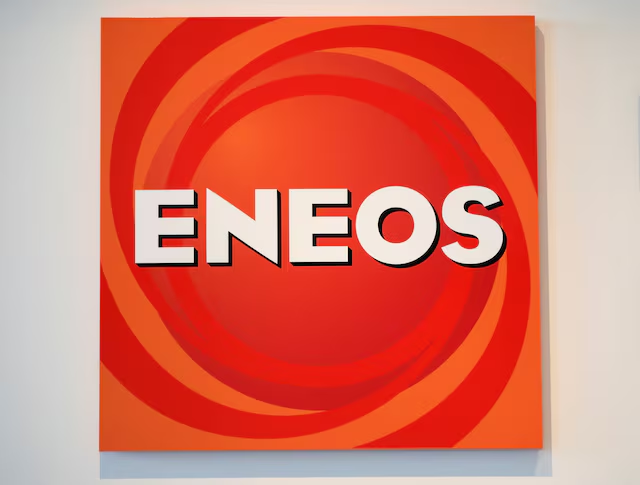The logo of Eneos Holdings and Eneos Corporation is displayed at the company headquarters in Tokyo, Japan, August 20, 2020. REUTERS/Issei Kato/File Photo
Japan’s top oil refiner, Eneos Holdings, has announced a strategic overhaul in its energy investment priorities as part of a new three-year business plan through fiscal 2027. The company intends to significantly boost investment in liquefied natural gas (LNG) and sustainable aviation fuel (SAF), while pulling back on its earlier ambitions in hydrogen and ammonia development, reflecting a shift in global and domestic energy considerations.
Unveiled on Monday, the plan outlines a total capital allocation of 1.56 trillion yen (around $10.7 billion), with 740 billion yen earmarked for strategic investments. Of this, 310 billion yen will be directed toward low-carbon energy sources such as LNG, 250 billion yen toward decarbonized initiatives like SAF and carbon capture, and 180 billion yen toward the company’s traditional oil and chemicals businesses. An additional 820 billion yen will be used to sustain Eneos’s refinery and core business operations.
CEO Tomohide Miyata emphasized the company’s renewed focus on energy solutions that offer both low-carbon benefits and greater energy security. “Given the rising risks associated with U.S. policy uncertainty, volatile global energy markets, and the cost pressures of decarbonization, we are narrowing our focus to areas with clearer return potential,” Miyata stated during a press briefing in Tokyo.
LNG has emerged as a centerpiece of Eneos’s strategy, with the company projecting continued demand growth until around 2040. Eneos already holds stakes in LNG projects across Asia and is actively considering investments in the United States, including participation in the Alaska LNG initiative. This move is designed to capitalize on LNG’s role as a transitional fuel amid tightening emissions standards and fluctuating energy supply chains.
In the SAF sector, Eneos is accelerating a joint venture with Mitsubishi Corporation to construct a production facility at its Wakayama refinery. The plant is slated to begin operations in fiscal 2028, targeting an annual output of 300,000 metric tons (approximately 400,000 kiloliters) of SAF. The feedstock will be sourced from waste materials and byproducts like used cooking oil and tallow, supporting both environmental goals and Japan’s push to establish a global supply chain for alternative aviation fuels.
In contrast to the ramp-up in LNG and SAF, Eneos is taking a more cautious stance on hydrogen and ammonia. The company has quietly dropped its earlier target of supplying up to 4 million metric tons of hydrogen annually by fiscal 2040. Miyata cited multiple concerns, including limited near-term demand, high infrastructure costs, and policy volatility—particularly in the U.S., where evolving tax credits and incentives for hydrogen have introduced new financial uncertainties.
“While hydrogen and ammonia remain long-term options, the market reality and technological readiness do not currently support aggressive investment at the scale we once envisioned,” Miyata said.
This marks a notable recalibration for Eneos, which had previously portrayed itself as a frontrunner in hydrogen fuel infrastructure, including filling stations and supply chains. The retreat suggests a broader reassessment of hydrogen’s immediate commercial viability, as companies worldwide weigh the technical hurdles and capital intensity of these cleaner but nascent technologies.
The revised plan reflects a pragmatic blend of decarbonization goals with the need for reliable and affordable energy supplies. While Eneos remains committed to Japan’s national climate goals and the global energy transition, its updated priorities signal a shift toward technologies that offer more immediate scalability and return on investment.
As global energy markets continue to evolve and geopolitical risks mount, Eneos appears set to pursue a more balanced path—leveraging its existing fossil fuel infrastructure while gradually transitioning to cleaner alternatives that promise practical and profitable applications.
Source: Reuters



